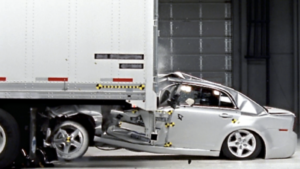What is Distracted Driving?
Distracted driving is engaging in another activity while driving a motor vehicle. It can be texting, talking on the phone, eating, adjusting the radio or air conditioning, playing video games, watching movies, putting on make-up, fixing your hair, or any of the other surprising tasks drivers try to complete while driving a vehicle.
How Dangerous is Distracted Driving?
Very. In the year 2020, more than 3,100 people were killed by distracted driving, according to the National Highway Transportation Safety Administration (NHTSA). Nearly 325,000 people were injured in such crashes in 2020, according to NHTSA.
Distracted Driving Laws
Many states, including Washington, have laws restricting the use of electronic vehicles while driving. RCW 46.61.672. The state of Washington also passed a law against “dangerously distracted driving.” RCW 46.61.673 It carries a penalty of thirty dollars and can only be enforced if the driver is caught for another infraction.
What Should I Do if I am Hit by a Distracted Driver?
If you are hit by a distracted driver, you should take many of the same steps as if you were in any other car crash. One problem with distracted drivers is they can be so distracted they don’t even realize they hit someone. Even more reason to call the police and seek help immediately.
If you are not so seriously injured you can’t help yourself, there are steps you can follow. Be careful about what you say after being struck by another car. Even an innocent “I’m sorry” may be used against you in court to try to prove that you were at fault. Check yourself and your passengers for injuries
- Move vehicles out of traffic (if the damage is minor) and turn on hazard lights
- Call 911
- Wait for help
- Exchange Information
- Document the accident and get a police report and witness information
- Notify your insurance and start the claims process.
Call 911
It is important to officially document the accident through a police report. There are several reasons for this:
- Your insurance company may require a police report to file a claim.
- The police will obtain and record the other driver’s insurance information.
- The police will gather and record the other driver’s contact information for you.
- The police will create an accident report with the details of the accident.
- The accident report is an official record that documents the accident. This stops the at-fault driver from claiming that “it never happened.”
What Information Should be Exchanged after a Car Crash?
Get the other driver’s full name and contact information. Get the driver’s phone number and email address; then, you’ll want to get the driver’s name and address from his driver’s license (as opposed to simply asking for it). In fact, take a picture of the license, if possible, so that you are sure that you have the correct information. Something that people can forget is to verify with the driver that the address on the license is accurate and current.
Get all of the passengers’ names and contact information. This goes not only for your passengers, but the passengers of the other vehicle.
Record the other driver’s license number and plate number. While getting the other driver’s contact information from his or her license, also record the driver’s license number. (If you took a photo of the license, that would obviously include this information.) In addition, write down the license plate number for the other driver’s car.
Note the other driver’s car information. You will want to record the type, make, and model of the other vehicle.
Record the details of the location. Note the details of the location and include things like cross-streets or other relevant information – like the location and details of nearby road construction, for instance. It is also important to note the weather conditions in as much detail as you can, especially if it was raining or foggy when the accident occurred.
Why Do I Need Insurance Information from the Other Driver?
If the other driver was at fault and the crash looks to be nothing more than a fender bender, the other driver might try to talk you out of getting their insurance information and offer to pay for your repairs out of their own pocket. The other driver might suggest this because he doesn’t want his insurer to raise his car insurance premiums or because he doesn’t have insurance at all. Under Washington state law, driving without insurance can result in a heavy fine and possible license suspension.
You should not agree to handle the crash “under the table” without exchanging insurance information. Here’s what can happen if you agree to handle the case outside the insurance system.
Another driver, at fault, hits your car in what appears to be a minor collision. The other driver offers to pay for your damage out of his pocket to “keep the insurance companies out of it.” He gives you his contact information and tells you to send him the bill. When you get to the auto repair shop, the estimate to fix the damage is way more than expected. Now the other driver, who thought the damages would only be a few hundred dollars, is looking at a bill in the thousands.
Then, you start feeling pain in your neck and back. You go to your doctor who tells you that you have soft tissue damage from the crash and that you are going to need extensive treatment and therapy. You’ll soon have tens of thousands of dollars in expenses from a collision that wasn’t your fault. When you try to contact the other driver for payment, your phone calls are ignored and you eventually have to file a lawsuit against the other driver.
If You Did Not Get the Other Driver’s Insurance Information
If you did not get the other driver’s insurance information, you do have some options, but they are more complicated than simply filing a claim through your insurance.
You could use your uninsured motorist coverage. Uninsured motorist coverage is not required by Washington law, but it is a good thing to have because it protects you when you are hit by an uninsured or underinsured driver. If you carry this insurance and are hit by a driver without adequate (or any) coverage, your insurance will pay your bills up to your policy limits. If you neglect to purchase this coverage, then you would be left to pay for your medical and property damage yourself.
You could file a lawsuit. You could go through the trouble and expense of filing a lawsuit in small claims court if the dollar value of the damages is not terribly high. But if your damages are extensive, then you’d need a lawyer to help track down the other driver’s insurance company and file a claim against them and/or their insurer.
When you get into a collision with another vehicle, you can’t count on the other driver to be nice. He or she has interests of their own to protect. You could use counsel from people who have driven this road before. Contact us today to schedule a consultation.


